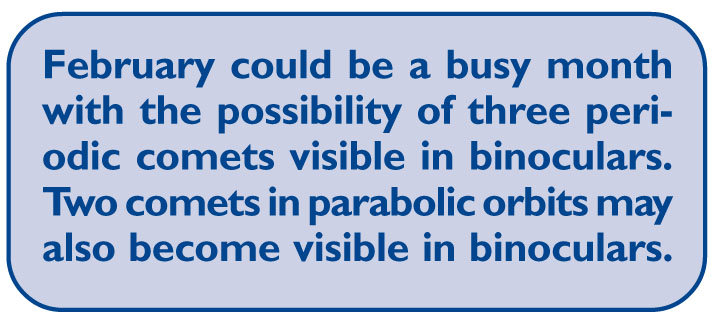Comet prospects for 2017
2016 November 21

These predictions focus on comets that are likely to be within range of visual observers, though comets often do not behave as expected and can spring surprises. Members are encouraged to make visual magnitude estimates, particularly of periodic comets, as long term monitoring over many returns helps to understand their evolution. Please submit your magnitude estimates to the Comet Section in ICQ format. Drawings are also useful, as the human eye can sometimes discern features that initially elude electronic devices.
Theories on the structure of comets suggest that any comet could fragment at any time, so it is worth keeping an eye on some of the fainter comets, which are often ignored. They would make useful targets for those making electronic observations, especially those with time on instruments such as the Faulkes telescopes. Such observers are encouraged to report electronic visual equivalent magnitude estimates via COBS. When possible use a waveband approximating to Visual or V magnitudes. These estimates can be used to extend the visual lightcurves, and hence derive more accurate absolute magnitudes. Such observations of periodic comets are particularly valuable as observations over many returns allow investigation into the evolution of comets.
Comet 2P/Encke makes its 63rd observed return to perihelion since its discovery by Mechain in 1786. The orbit is quite stable, and with a period of 3.3 years apparitions repeat on a 10-year cycle. This year the comet is well seen from the northern hemisphere prior to perihelion, which is in mid-March.
The comet starts the year as a telescopic object, but quickly brightens and could be a binocular object by mid-February. It is however dropping rapidly into the northern dusk and will be lost by early March. It may be visible in the LASCO C3 field of the SOHO spacecraft from March 9 to 14. It then emerges rapidly into southern hemisphere skies, but fades equally quickly.
BAA visual observations over the last 60 years show little change in the comet’s absolute magnitude. The comet is the progenitor of the Taurid meteor complex and may be associated with several Apollo asteroids. This suggests that on occasion it may outburst, though nothing major has been detected to date.
Alexandre Schaumasse discovered 24P/Schaumasse during a visual search with the 400mm Coudé equatorial at Nice, France in Dec 1911 as a mag 12 diffuse object, and it reaches a similar magnitude at average returns. The 1952 return was very favourable and the comet reached 5th magnitude, though there may have been an outburst. The orbit is relatively stable and this will be its 12th observed return. It is a morning object throughout the brighter part of its apparition, so that despite a predicted peak of mag 10 most observations are likely to be electronic and made with robotic telescopes.
29P/Schwassmann–Wachmann is an annual comet that has outbursts, which over the last decade seem to have become more frequent, though this could just reflect more intense coverage… (continued)
(Login or click above to view the full article in PDF format)
| The British Astronomical Association supports amateur astronomers around the UK and the rest of the world. Find out more about the BAA or join us. |
